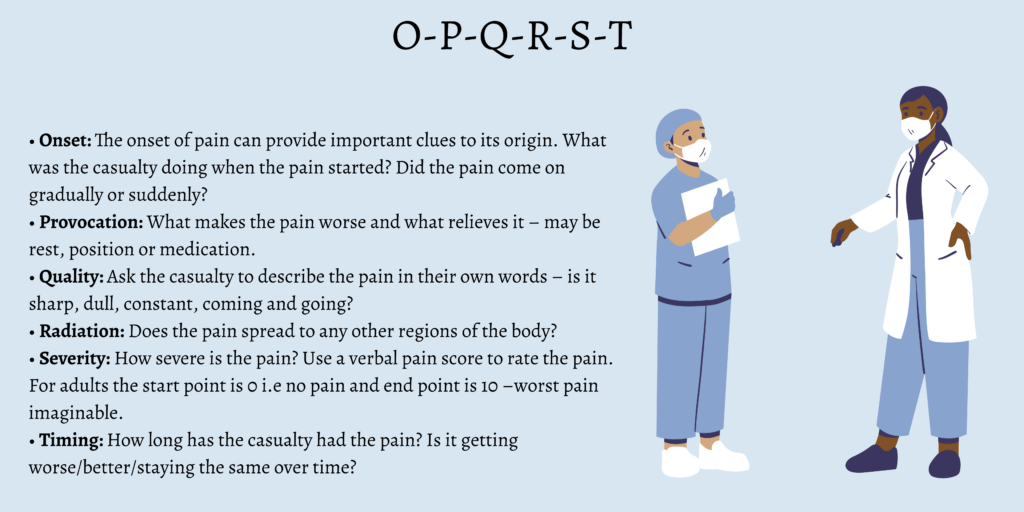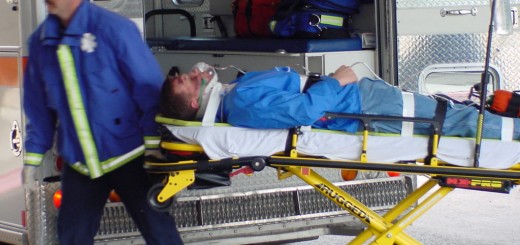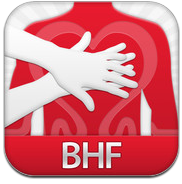What does OPQRST stand for in first aid?
OPQRST is a memory device (mnemonic ) used by first aiders and healthcare professionals to assess and understand a patient’s pain.
Many medical emergencies result in pain, but it’s not always easy for patients to describe their pain or possible reasons for it in a way that a healthcare professional or a first aid provider can accurately interpret.
So, to aid communication and get to the root cause of a person’s pain, doctors have developed the OPQRST method. It’s frequently used in healthcare settings by physicians, nurses, paramedics, and EMTs, but it can also be a useful tool for first aiders and first responders.
In this post, we’ll examine the components of OPQRST so that you can be confident in utilizing it in a real-life medical emergency or first aid situation.
OPQRST stands for:
• Onset
• Provocation
• Quality
• Radiation
• Severity
• Timing
Below, we’ll go through each of these components in turn.
Onset
The onset of pain can provide important clues to its origin. So, what was the patient doing at the time the pain started? Were they active, sedentary, sitting, standing, feeling stressed, or relaxed?
We also need to know whether the onset of the pain was sudden or gradual. Has the patient experienced this kind of pain before, or is this the first time?
Provocation
What makes the pain worse, and what relieves it? For example, some pain may be relieved by rest, and other types of pain subside with movement and feel more intense when standing or sitting still.
Does pressing on the area make the pain worse or better? Has the patient tried any medications for the problem, and if so, did this help to relieve the symptoms?
Quality
This refers to the patient’s own description of the pain. Ask the casualty to define their pain in their own words. Pain is a subjective experience that can be difficult to communicate to someone else, but be sure to let the casualty describe their pain without putting words into their mouth.
If the patient struggles to assign a description to their pain, you may offer them some prompts as a last resort. For example, is the pain sharp, dull, constant, or coming and going? Is there a crushing, burning, tearing, or throbbing sensation? Does it ache, fizz, or pulse?
Region and Radiation
Where is the pain, and does it radiate or spread to other regions? Certain conditions are characterized by pain that radiates to specific parts of the body. For example, a person suffering from a heart attack may experience pain that radiates from the chest to the arms, back, neck, or jaw.
Finding out the primary location of the pain and where it radiates to can help provide valuable clues to a patient’s condition.
Severity
How severe is the pain? Use a verbal pain score to rate it from 1 to 10. For adults, the start point is 0, i.e., no pain, and the endpoint is 10, which is the worst pain imaginable.
If applicable, you might also ask the patient to rate their pain now versus their pain at the onset of their symptoms. Or their pain rating with movement versus without.
Remember, pain is subjective, and everybody has a different threshold and tolerance level, so keep an open mind when listening to the patient’s response.
Some people, for example, children and adults with learning disabilities, may be unable to understand a verbal pain rating scale. In this case, there are several alternative methods you can use to assess pain, such as the Wong-Baker faces pain rating scale (https://wongbakerfaces.org/).
Timing
Time refers to how long the patient has had the pain. When did it start? For example, did the patient feel some minor twinges a few days ago, or did it suddenly start for the first time today? Is it getting worse or better, or is it staying the same? Try and picture a graph of the pain over time.
Conclusion
Understanding a casualty’s pain is the first step in identifying a potential condition or medical emergency.
As a first aider or first responder, you can implement the OPQRST method to talk to a casualty about their pain and identify its possible causes. This can help inform you what to do next.
Plus, in a medical emergency, the OPQRST method helps you to gather vital information to pass on to medics that could help to save a person’s life.






